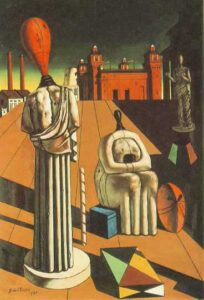Among the many Italian artists who lived in the past century, the painter Giorgio de Chirico was undoubtedly one who always managed to stir up emotions and astonishment, as well as much criticism. In order to celebrate this 20th-century master, Palazzo Reale organized a retrospective exhibition which includes hundreds of artworks, including juvenile paintings, portraits and mannequins, all displayed in a thematic itinerary made up of hardly repeatable comparisons and combinations.
Born in 18

88 in Volos, Thessaly, de Chirico was the son of a railway engineer. After his father’s death he left Greece with his family and travelled to Italy and abroad. He always stayed true to his Hellenic roots and to classic mythology, and thanks to his amazing technical ability he was known as “Pictor Optimus”. He managed nonetheless to modernise classical art, dispossessing art of its usual content, rules and tendencies.
Fascinated by Nietzsche’s philosophical theories, including the idea that the whole world was a “non-sense”, he considered art as a product, born from enigma, and the mystery enclosed in all things, especially the most simple and insignificant ones. He transfigured ordinary objects, and his paintings are filled with cookies, set squares, maps and all the other objects present in his home and life. He also turned myth into enigma, giving birth to a new artistic avant-garde movement called ‘metaphysical art’.
He exhibited La Matinée Angoissante as early as 1912, including all the elements later found in the famous series ‘Italian Squares’, which are the core of his metaphysical art.
Squares are envisioned as encased in rectangles, in which a clock, a tower, statues, a train and the perspective escape from the ever-present archways and piazzas. Everything is overcast with a feeling of suspense, and appears under an unnatural light; shadows take on a physical presence that stand out upon a clear horizon.
De Chirico made Nietzsche’s concept of super-human his own. He believed himself to be the best and in 1912 he painted an almost narcissistic self-portrait, depicting himself like Nietzsche in a similar posture to that held by the German philosopher in the famous painting.
He was very sarcastic and caustic regarding life, he enjoyed scandalizing the art community: he portrayed himself wearing only his underwear, dressed up as a bullfighter and once also with his torso petrified. Criticisms didn’t bother him and he kept switching from figurative to metaphysical art, though always staying true to himself and his origins.
In 1992 he painted The Prodigal Son. When painting the statuary father who hugs the mannequin son, his goal wasn’t to represent the Gospel parable, but to allude to the necessity of returning to the rules of the old masters after all the avant-garde experimentations. All this represented de Chirico moving back to his homeland and to classicism after the years he spent in Paris.
In 1934 he created the fascinating series ‘Mysterious Baths’, where these same elements can be found in every art piece: boats, men both dressed and naked submerged in ‘water’ with the floor of the pool having a parquet motif. Everything appears still and mysterious in a surreal perspective, as if it were a visual “non-sense”.
By the end of the 50s, with his painting The Disquieting Muses, he began a new journey, which was almost a repetition game: he returned to his old themes and subjects. Together with his brother Savinio he started to replicate his metaphysical work.
He combined past and present, truth and falsehood through irony; he took part in everything even though he belonged to no one, as he lived in his own world, that is the world of the Greek myths of his youth.
He died in Rome in 1978.
Loretta Pettinato
Translated by Laura Pettinato
Volume 34 no 3 January – February 2020 p 20
